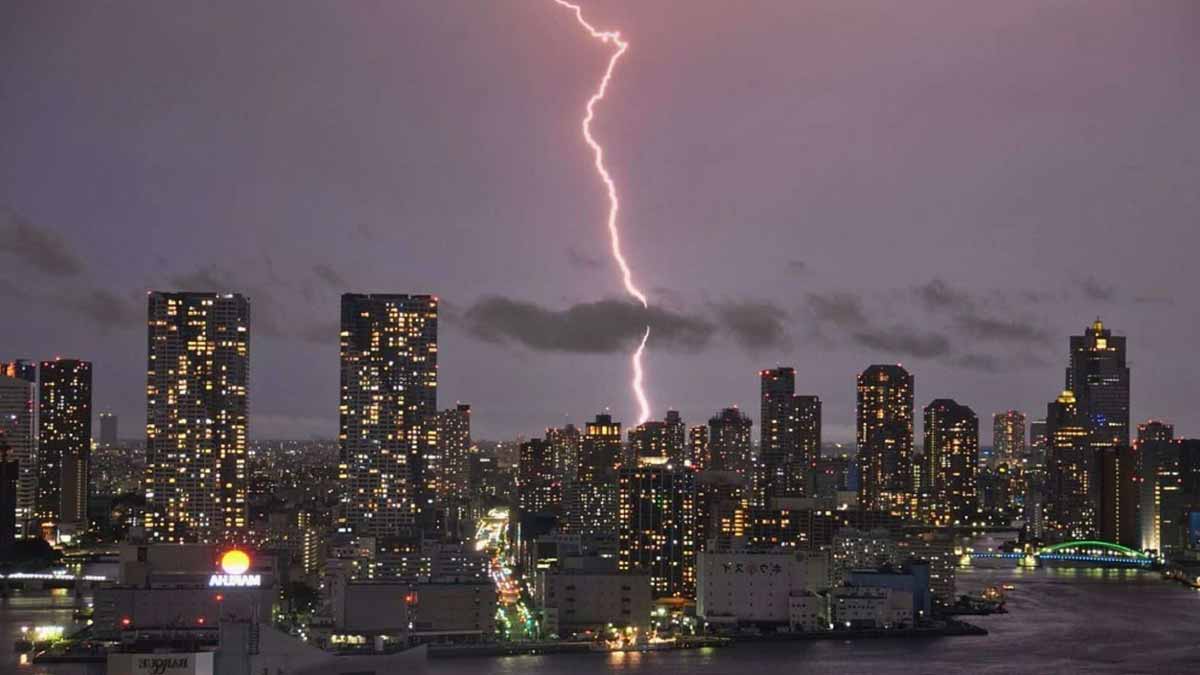Storm clouds no longer dictate the rules; Japan just taught them to listen. In a first-of-its-kind leap, engineers sent drones into the charged air to invite a bolt and then guide its path, turning raw danger into controlled behavior. The result points to safer grids, steadier transport, and events that continue even when the sky turns hostile. Mobility replaces guesswork, precision replaces luck, and a once untouchable force now meets a tool designed to move with it.
Shimane field tests: purpose, setting, and controlled strikes
Between December 2024 and January 2025, researchers ran open-air trials near Hamada City in Japan’s Shimane Prefecture. They sent a specially built aircraft to about 300 meters as the electric field intensified under an incoming thundercloud. When conditions aligned, a ground switch perturbed the field and set the stage for a controlled discharge.
The experimental platform acted as the preferred target, pulling the bolt safely by design. The process relied on timing, measurement, and repeatable triggers, rather than chance. Because the aircraft carried a robust protective cage, the team could test again after impact, then analyze telemetry and structural response with fresh confidence, while keeping personnel out of harm’s way.
The goal reached beyond spectacle and toward practical shielded mobility. The system showed that drones can stand in for fixed rods, then move, watch, and guide. That mobility matters for isolated assets, windy ridgelines, and temporary venues where fixed hardware is impractical or arrives too late to help.
How drones survived the strike and kept flying
The airframe sat inside a lightning-resistant cage engineered to attract and contain the current. Tests measured 98 percent protection coverage around the vehicle. The cage endured currents up to 150 kA—about five times stronger than typical natural strikes—without transferring catastrophic energy to flight-critical components, which preserved control and stability.
Even after the discharge, the vehicle remained steady in midair. The shielding channeled the surge, while onboard systems continued to operate and send data. Engineers confirmed structure, motor function, and navigation responsiveness, then repeated passes to validate resilience under variable field strengths. Stability during and after impact changed the conversation from theory to dependable practice.
Traditional defenses stay put and protect only their immediate radius. A mobile, guided target can go where risk surges, then pull the strike away from vulnerable equipment. Because the cage compartmentalizes energy and limits pathways into avionics, the aircraft resumes work swiftly, which supports reliable operations under fast-changing storm conditions.
Economic stakes, protection gaps, and mobile coverage
Japan loses an estimated ¥100 to ¥200 billion each year to lightning damage, roughly $700 million to $1.4 billion. Losses accumulate across grids, telecom towers, rail, factories, and events. Fixed rods help, yet distance, terrain, and temporary setups often leave blind spots that a stationary mast simply cannot cover.
Wind turbines on remote ridges and outdoor stages in wide fields illustrate the gap. Their exposure changes with weather and layout, while access is tough. A mobile platform can patrol as storms form, then position itself to redirect danger. With this in mind, planners gain a flexible layer that complements grounding meshes and surge devices.
As the trials show progress, the long-term vision is bold : completely prevent strikes on critical infrastructure and metropolitan areas by guiding discharge paths away from sensitive locations. Because drones can reposition quickly, they promise targeted shielding, better continuity of service, and fewer expensive outages, with safety benefits that reach workers, spectators, and nearby residents.
Networks, guidance, and the road to energy capture
The effort involves collaboration with Fujitsu, pairing sensing, control, and communications across multiple vehicles. A coordinated network can watch thundercloud evolution, select a safe sink, and deliberately induce a strike toward a planned landing point. That orchestration turns a chaotic hazard into a managed, auditable electrical event.
Researchers also put forward an energetic next step: capture and reuse part of the discharge. The ambition is to store energy from induced lightning for practical applications. While difficult, the idea pushes surge management toward value creation, linking high-energy, short-duration events with storage, conversion, and experimental power electronics designed for extreme transients.
Guidance improves prediction. When a network can trigger and steer, it also learns. Each controlled event feeds models of charge separation, leader formation, and ground coupling. With better maps of strike zones and evolving fields, operators can place equipment smarter, schedule sensitive work with less risk, and reduce surprise outages without mentioning drones again here.
Research frontiers, urban scaling, and responsible deployment
Controlling lightning in the open changes the research toolkit. Teams can time events, measure currents, and test materials under known conditions instead of waiting for chance. That means faster iteration on shielding, grounding interfaces, and inspection protocols, with cleaner comparisons between designs and clearer thresholds for safe operation.
Scaling to cities and critical corridors will demand procedures, training, and clear airspace rules. Operations must fit with aviation authorities, emergency services, and utilities. Weather windows remain decisive, yet flexible fleets shorten response times. Because public trust matters, transparent criteria, visible safety perimeters, and straightforward notices will help communities accept storm operations nearby.
Future trials should replicate results across terrains and seasons, then quantify benefits against conventional defenses. Comparisons may include avoided damage, restored uptime, and fewer disruptions to rail or power. As reliability grows, drones could sit on standby at substations, ports, or event parks, then launch when sensors say a dangerous field is building.
Why this could reshape safety, energy, and storm science worldwide
A controlled strike that leaves the aircraft stable marks a turning point. Mobility closes protection gaps, while targeted guidance reduces costly outages. With a path to capture and store part of the surge, the advance even hints at new energy research. As systems expand, drones could change how we face severe weather—proactively, precisely, and safely.
